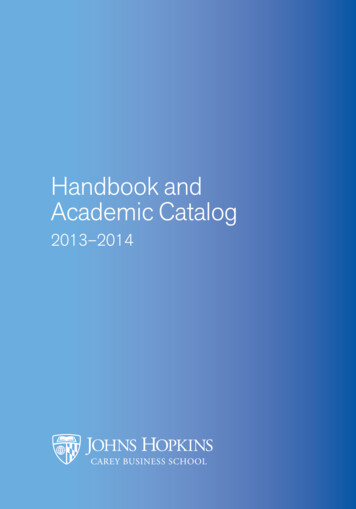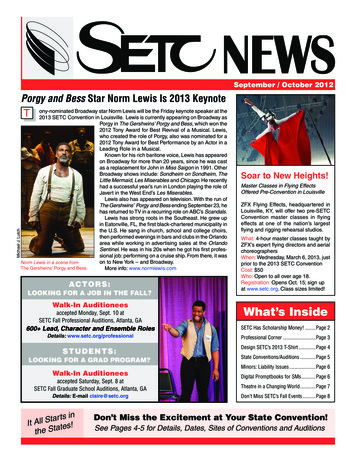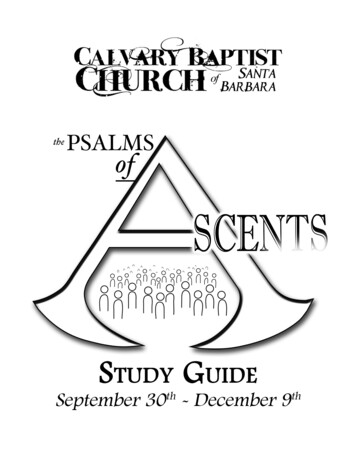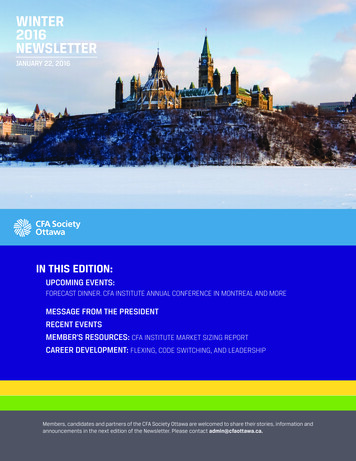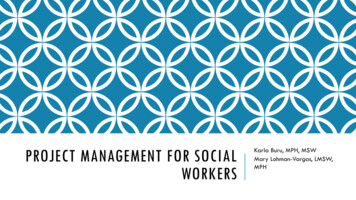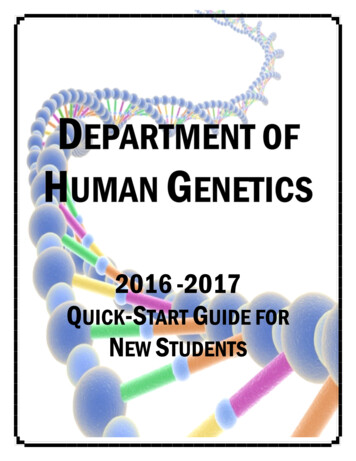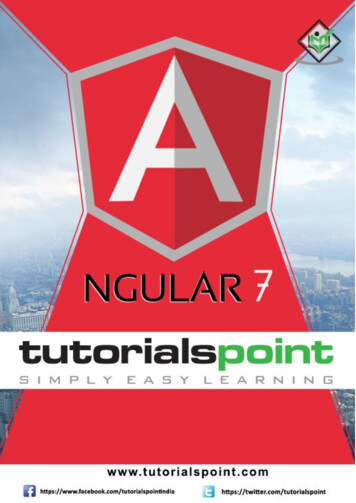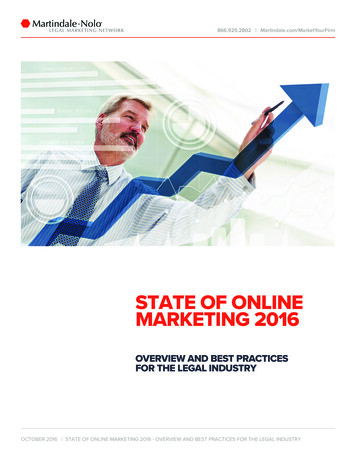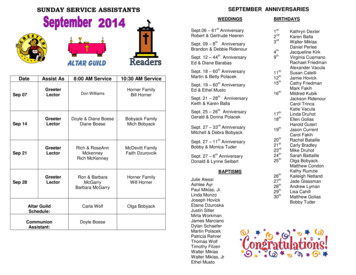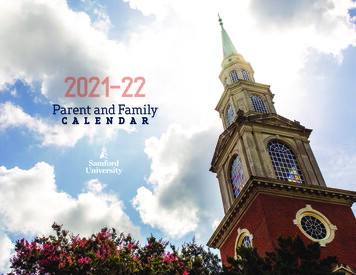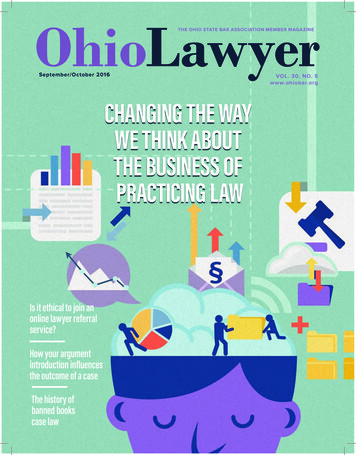
Transcription
THE OHIO STATE BAR ASSOCIATION MEMBER MAGAZINESeptember/October 2016CHANGING THE WAYWE THINK ABOUTTHE BUSINESS OFPRACTICING LAWIs it ethical to join anonline lawyer referralservice?How your argumentintroduction influencesthe outcome of a caseThe history ofbanned bookscase lawVOL. 30, NO. 5www.ohiobar.org
Protecting your reputationbefore, during and after the storm.OBLIC is there to protect yourreputation when you need it most.Reputation Matters. Let OBLIC Protect Yours.Owned and Proudly Endorsed by the OSBA,OBLIC is the only carrier exclusively devoted toprotecting Ohio attorneys. #REPUTATIONMATTERSVisit www.oblic.com to Apply Nowor call (800) 227-4111 for more information.www.ohiobar.org
OhioLawyerVol. 30 No. 5Departments2 Letter to the EditorReader responds to recent article3 President's PerspectiveBreaking barriers: Reducing subtle biasesrequires constant conversation and educationFeatures10 Tort reform, apportionment & immunityby Matthew B. Barbara and Clifford C. MaschApplying Ohio’s tort reform legislation to a situationwhere a non-party is immune from the tort liabilityin issue has resulted in contradictory holdings.5 Inside OSBAFall District Meeting schedule ; Law and MediaConference 20166 Foundation News2016 Annual Awards Dinner Honorees7 16 Limited scope representation: A newway of thinking about accessible legalservicesby Eileen Pruett and Bert Tiger WhiteheadUnbundling legal services is still taboo for manyattorneys. Although it may not be the best optionfor large firms, it can help solo practitioners gainclients while improving access to justice.22 Disqualification, disgorgement anddiscipline as the price of disloyaltyby Lindsey Carr Siegler and Michael E. SmithHow do attorneys remain loyal to their clientswhen conflicts of interest arise? What are theirethical and professional obligations to theirpractices, their clients and themselves? A reviewof recent cases will help determine which route totake in these scenarios.Member NewsCommittee and section fall meetings; awardsand community involvement of OSBA members8 Books & Bytes3 opinions that shaped the current legalprecedent for banning books28 Practice TipsSticky service situations: Obtaining service inunusual circumstances30 Practice TipsThe value of a strong introduction32 Beyond the CourtroomThe Ohio lawyers who saved AbrahamLincoln’s life34 Counsel CommentsIs it ethical to join an online lawyer referralservice?36 CLE CalendarSeptember and October programswww.ohiobar.orgSeptember/October 2016Ohio Lawyer1
OhioLawyerOhio Lawyer is published bimonthlyby the Ohio State Bar Association.Ohio Lawyer StaffEditor: Nina CorbutEditorial: Tori MetzgerGraphic Designer: Chris LochinskiWebsite Editor: Dan BeckleyContent Advisory BoardJudge David Hejmanowski, Chair,DelawareSteve Bolton, YoungstownAlicia Graves, ClevelandThomas L. Guillozet, VersaillesPaul Hervey, New PhiladelphiaRachael Ingram, WestervilleWilliam Kaufman, LebanonOSBA OfficersPresident:Ronald S. Kopp, AkronPresident-elect:Randall M. Comer, SpringfieldKris Long, ColumbusJoseph L. Ludovici, East LiverpoolKevin P. Murphy, WarrenErin Rhinehart, DaytonStephen L. Smith, New BremenJudge James Stevenson, SidneyDear editor:[This letter was written in response to an articlefrom the May/June 2016 issue of Ohio Lawyertitled "Permissible scope of an interrogatory."]Penn Central was a pre-Civil Rules fact pattern whichfavored little or no discovery before trial. The Ohio CivilRules favor as much discovery as economically possible.Penn Central and those who support it are not doing thecurrent civil justice system any favors by using it. EvenJudge McBride, when he got to the court of appeals,stated his 1971 decision was limited in its application.How does a 1971common pleas case fromSouthern Ohio haveany precedential valueall across Ohio? Thereis no reference to PennCentral in the OhioCivil Rules comments.There are no exceptionsin the Ohio Civil Rulesfor those who wouldOhio courts applyprefer doing depositionsCleveland attorneyAccess to justice:case-within-a-casegrants wishesA one-year reportdoctrinerather than answeringinterrogatories orproduction requests. And, merely because there arealternative ways of gathering information, including oraland written depositions, does not mean that the Rules statea preferred or better way. There are plenty of Ohio litigantswho cannot afford the high cost of depositions. Manycases do not warrant economically that kind of litigation.THE OHIO STATE BAR ASSOCIATION MEMBER MAGAZINEExecutive Director:Mary Amos AugsburgerAdvertising Sales and Editorial OfficesOhio State Bar AssociationP.O. Box 16562Columbus, Ohio 43216-6562(800) 282-6556; (614) 487-2050Letter to the editorAdvertising: ODelGarbino@ohiobar.orgEditorial: ncorbut@ohiobar.orgPrinting: Hopkins PrintingEditorial OfficesOhio Lawyer (issn 1097-6493) is published bimonthly by the Ohio State Bar Association,P.O. Box 16562, Columbus, Ohio 43216-6562. Phone: (800) 282-6556 or (614) 4872050. Periodicals postage paid at Columbus, Ohio and additional offices. Ten dollars of duespays your required subscription to Ohio Lawyer.Ohio Lawyer is published as a service to members of the Ohio State Bar Association throughtheir dues and is not available to nonmember attorneys. Governmental agencies andeducational and legal research organizations may subscribe annually for 35. Single copies tomembers and qualified subscribers are 7. Copyright 2016 by the Ohio State Bar Association. All rights reserved. Any copying ofmaterials herein, in whole or in part, and by any means, without written permission, is prohibited. Requests for reprint permission should be sent to the Ohio Lawyer editorial offices.Editor reserves the right to reject any advertising submitted for publication. While advertising copy is reviewed, no endorsement of any product or service offered by any advertisementis intended or implied by publication in Ohio Lawyer. Statements or expressions of opinionherein are those of the author and not necessarily those of the Ohio State Bar Association, itsofficers, staff or the board of editors.May/June 2016VOL. 30, NO. 3www.ohiobar.orgOSBA members are encouraged to submit manuscripts to the editor for possible publicationin Ohio Lawyer. Articles submitted should not exceed 10 typewritten, double-spaced pages.Manuscripts are not purchased, and those submitted become the property of the Ohio StateBar Association. Editorial policies can be obtained by calling (800) 282-6556 or (614)487-2050 or visiting www.ohiobar.org/editorial policy.Penn Central is not good nor favored law. Using it toavoid answers to interrogatories because they call for “anarrative response” misses the point of our Civil Rules.We need no amendments to Civil Rule 33. We needto recognize that Penn Central is not precedential lawin Ohio and that any interrogatory which seeks Rule26-relevant information must be answered fully.Postmaster (USPS 016-304): Send address changes to Ohio Lawyer, P.O. Box 16562,Columbus, Ohio 43216-6562.Michael P. Harvey, Esq., Rocky RiverManuscript SubmissionArtwork credits Shutterstock.com/g/whanwhan.ai: Cover Shutterstock.com/g/Rafa Irusta: 1 Shutterstock.com/g/Rido: 4 Shutterstock.com/g/ Pressmaster: 5, 24 Shutterstock.com/g/jorisvo: 8 Shutterstock.com/g/ ra2studio: 10-11 deviantart.com/g/ Konstantin Faraktinov: 12-13 Shutterstock.com/g/andiphoto: 15 Shutterstock.com/g/Cienpies Design 16-17,192Ohio Lawyer Shutterstock.com/g/Macrovector 20 Shutterstock.com/g/Macrovector 22 Shutterstock.com/g/oneinchpunch 25 Shutterstock.com/g/Roman Yanushevsky 28 Shutterstock.com/g/Everett Collection 30 Shutterstock.com/g/bizvector 34 Shutterstock.com/g/Rawpixel.com 35 Shutterstock.com/g/Matej Kastelic 36September/October 2016www.ohiobar.org
President's PerspectiveBreaking barriers:Reducing subtle biasesrequires constantconversation and educationBy Ron KoppLawyers have often led the chargetoward greater justice and equality.While growing up in a slave culture,Alexander Hamilton later arguedfor abolition of slavery during theConstitutional Convention. AbrahamLincoln signed the EmancipationProclamation. Thurgood Marshallsuccessfully argued Brown v.Board of Education before theU.S. Supreme Court in 1954.In 1968, then-OSBA President NortonWebster admonished members ofthis Association in his address at theend of his term that lawyers in Ohioneeded to do better to assist AfricanAmericans to enter and succeed inour profession. He noted that of 500people passing the bar exam that year,only five were African American. Healso noted that African Americanlawyers found it almost impossibleto lease quality office space in Ohio’smajor cities due to racist attitudes.On a larger stage during that same year,attorney (and presidential candidate)Robert Kennedy addressed a crowd inIndianapolis immediately followingthe assassination of Martin LutherKing. I was in eighth grade, and I havea clear memory of seeing parts of thespeech on the next night’s news. Tryingto calm outraged people in that cityand across the country, he made onewww.ohiobar.orgof the great speeches of the twentiethcentury. On that horrible night, onewhich I remember well, he said:What we need in the United Statesis not division; what we need inthe United States is not hatred;what we need in the United Statesis not violence and lawlessness,but is love, and wisdom, andcompassion toward one another,and a feeling of justice towardthose who still suffer within ourcountry, whether they be whiteor whether they be black.So I ask you tonight to returnhome, to say a prayer for thefamily of Martin Luther King.but more importantly to saya prayer for our own country,which all of us love—a prayerfor understanding and thatcompassion of which I spoke.We can do well in this country. Wewill have difficult times. We’ve haddifficult times in the past, [ ] andwe will have difficult times in thefuture. It is not the end of violence;it is not the end of lawlessness;and it’s not the end of disorder.But the vast majority of whitepeople and the vast majorityof black people in this countrywant to live together, want toimprove the quality of our life,and want justice for all humanbeings that abide in our land.As we know, Robert Kennedy wasassassinated, himself, two months later.While there surely has been somemodest improvement over the years,racial divides remain all too prevalentin our society. It is true that explicitdiscrimination has declined, butdiscrimination nonetheless remainspalpable in its more subtle forms. Allof us know that subtle means can haveprofound consequences. Witness thatby many accounts, African Americanstoday are 30% more likely to be pulledover by law enforcement than arewhites, and they receive sentencesalmost 10% longer upon conviction.Most stark, though, is the propositionthat African Americans are up to 2.5times more likely to die as the resultof police action than are whites.As I wrote in a letter to our membersin July, such facts do not justify anycitizen to engage in violence againstany law enforcement officer. The vast,vast majority of law enforcementofficers are dedicated to upholdingall of the values of our society, andthey risk their lives every day for ourprotection. In fact, our police forcesSeptember/October 2016Ohio Lawyer3
As lawyers educated concerning the rule of law, we have a unique opportunity (indeed,I believe a special obligation) to lead and teach about democracy. A democracy whichfails to include every citizen on equal footing is short of a full democracy.too often are asked to do far morethan we should be asking. They arerequired to deal with society’s veryworst problems when no one else will.Enforcement of the law is largely areflection of our society. Until weobliterate from our landscape all formsof discrimination, there will be lawenforcement officers who act improperlybased on their explicit or implicitbias. The challenges experienced inSt. Paul, Dallas and Baton Rougeare societal challenges. Blaming lawenforcement absent an inward lookat ourselves as a society is naive. Wemight as an ideal expect more fromour law enforcement departments thanwe expect of ourselves, but that is anideal not based in practical reality.It is time to consider that the oathtaken by anyone who enforces the lawno more shields them from their biasesthan any one of us. The only thingthat will prevent hate and divisionfrom drawing us into chaos is theconscious regard for the rule of law anda willingness to examine any thoughtthat would thwart the sacred, solemnpromise made to uphold the law.4Ohio LawyerAs we continue to strive for greaterjustice in the form of racial equality (andequality for all groups in our society),our task is to address subtle biases in theform of implicit or subconscious racism.Such is a topic involving psychologyand sociology. Many, including me,entertain biases of which we are barelyaware. This is an obstacle that will notbe overcome in one, or even two orthree, generations. The problem requiresconstant conversation and education.As lawyers educated concerningthe rule of law, we have a uniqueopportunity (indeed, I believe a specialobligation) to lead and teach aboutdemocracy. A democracy which failsto include every citizen on equalfooting is short of a full democracy.I have promised to focus on the issueof diversity and inclusion during myyear as president. At the April OSBAForum in Cincinnati, we held aSymposium on Race and Its Impact onthe Practice of Law. At that Forum, Ibegan discussions with a number of theminority bars across the state. In earlyAugust, I (and others associated withthe OSBA) participated in anothersymposium on the same subject, held inColumbus. I continue to speak on thisSeptember/October 2016topic throughout the state. And I willcontinue to meet with the leadershipof specialty bars throughout Ohio.Clearly, we need to cause our lawfirms and our benches to become morediverse. As we serve on communityboards, we need to strive for morediverse participation. But perhaps mostimportantly, we, the lawyers of Ohio,must lead our conversations in thedirection of higher civility and greaterknowledge. While we can’t solve allproblems related to race and violence inour country, we can certainly educate,lead and make a difference. In largeand small ways, other lawyers beforeus have done so, and we are obligatedto continue that important tradition.It was in 1968 that I decided to becomea lawyer—largely moved by the politicalforces of that day. Since that time, I’venot once lost the ardent desire to makea difference whenever and wherever Ican. I will continue to do that in myown small arena as president of this bar.Wherever and whatever your arena,please join me in doing the same.Ronald S. Kopp is the president ofthe Ohio State Bar Association andpartner at Roetzel & Andress.www.ohiobar.org
Inside OSBASave the date for your2016 Fall OSBA District MeetingPlease plan to attend your 2016 Fall OSBA DistrictMeeting. The lunch meeting will start at 11:30 a.m. withan afternoon 2.5-hour CLE seminar. Register for yourDistrict Meeting online at ohiobar.org/districtmeetings.District 4 Annual MeetingMonday, Sept. 12 at The Toledo Club, ToledoCONFERENCEDistrict 3 Annual MeetingTuesday, Sept. 13, at Serrick Campus Centerat Defiance College, DefianceCOLU M BUSOCTOBER 14, 2016District 8 Annual MeetingTuesday, Sept. 20, at Lake White Club, WaverlyDistrict 16 Annual MeetingThursday, Sept. 22, at Shawnee Country Club, LimaDistrict 5 Annual MeetingMonday, Oct. 10, at Trillium Event Center, BucyrusDistrict 6 Annual MeetingMonday, Oct. 17, at Courtyard by Marriott, SpringfieldDistrict 13 Annual MeetingTuesday, Oct. 25, at Salem Golf Club, SalemDistrict 18 Annual MeetingWednesday, Oct. 26, at Avalon Inn, WarrenDistrict 14 Annual MeetingMonday, Nov. 14, at McKinley Grand Hotel, CantonThe 2016 campaign season has been interesting sofar, but you haven’t heard everything until you’veheard from prominent members of the bar, bench andpress at this year’s Law & Media Conference.The opening plenary session, moderated by attorney DanTrevas, will explore how “dark money” and “legalized lying”have shaped this year’s campaign season. The conference,which will be held at the Ohio State Bar Associationin Columbus on Friday, Oct. 14, will bring togetherjournalists, lawyers, academics and students for a day ofstimulating discussions about current media law topics.Session topics include anti-SLAPP laws, FERPA, bodycameras, the First Amendment right to anonymous speech,public records, student privacy vs. access to records, socialmedia’s effect on copy editing, and the Open Meetings Act.For details and registration information as itbecomes available,visit ctober 2016Ohio Lawyer5
Foundation NewsJoin us as werecognize excellencein the professionNominated by their peers, theseattorneys prove that “paying itforward” is worthy of recognitionand celebration. Please join the OhioState Bar Foundation on Friday, Oct.7, in Columbus as we gather to honorthese men and women and sharetheir inspirational stories from thefront lines of the legal profession.2016 Annual Awards DinnerHonorees:Sandra J. Anderson, ColumbusRitter AwardRonald L. Kahn, ClevelandRamey Award for DistinguishedCommunity ServiceSummit County Juvenile CourtCrossroads Program, AkronOutstanding Program AwardDrew Odum, ClevelandStatewide Community ServiceAward for Attorneys 40 & UnderDuring the 2015 Awards Dinner, Robert McClendon met Fred J. Ball, recipient ofthe Ritter Award. Mr. McClendon was wrong fully convicted and released from prisonwith help from Outstanding Program Award honoree, the Ohio Innocence Project.HONOR. REMEMBER. CELEBRATE.Honor the exceptional, celebrate an occasion and recognize thesignificant people in your life with a charitable gift to OSBF. Tributegifts are an easy way for you to support OSBF grant-making initiativesand to ensure special colleagues, friends and family receive the statewiderecognition they deserve. To dedicate your gift,call (614) 487-4477 or visit www.osbf.net and click “Donate Now.”When:Friday, Oct. 7, 2016 6:30 p.m.Where:Embassy Suites Columbus-Dublin5100 Upper Metro Place,Dublin, Ohio 43017RSVP:RSVP to Kristin Eckert atkeckert@osbf.net or(614) 487-4474 by Sept. 23.Cost per person is 75and seating is limited.CONNECTWITH OSBF6Ohio LawyerIN HONOR OFIN MEMORY OFGifts received fromMay 30, 2016 to July 15, 2016Gifts received fromMay 30, 2016 to July 15, 2016John C. ChildersKathleen A. StonemanDottie BelfrageMary Amos AugsburgerBeth Ann GillespieMs. Susan L. Rhiel, Esq.Gene KoppMary Amos AugsburgerHon. Howard H. Harcha IIIJohn & Wendy HolschuhCarmen V. RobertoFred J. MilliganM. Jebb Linch, Esq.Betty MousheyCarmen V. RobertoTwitter: @ OSBFFacebook: facebook.com/OhioStateBarFoundationLinkedIn: ember/October 2016www.ohiobar.org
Member NewsClevelandJennifer Lawry Adams,Ulmer & Berne LLP, was named to theLeadership Cleveland Class of 2017.Mary Jane Trapp,Thrasher Dinsmore & Dolan,earned the 2016 Inspire Awardfrom the McGregor Foundation.Stephanie Dutchess Trudeau,Ulmer & Berne LLP, was appointedto serve as a member of the OhioState Bar Association’s Labor &Employment Specialty Board.CincinnatiIn Memoriam2016John D. Holschuh, Jr.,Santen & Hughes, wasinducted into the InternationalAcademy of Trial Lawyers.Dwight A. Washington 66DaytonJune 2, 2016Jason A. Mosbaugh,Weltman, Weinberg & Reis Co.,was appointed by the board ofdirectors of the Cincinnati ParalegalAssociation to serve as a member ofthe organization’s Advisory Council.DaytonErin Rhinehart, Faruki Ireland &Cox, has been named to BenchmarkLitigation’s “Under 40 Hot List.”For more details and to register for a meeting, visit ohiobar.org/membermeetings.Estate Planning, Trust & ProbateSectionSaturday, September 17, 2016Estate Planning, Trust &Probate SectionBanking, Commercial &Bankruptcy Law CommitteeThursday, September 22, 2016Taxation Law CommitteePublic Utilities CommitteeFriday, September 23, 2016Administrative Law CommitteeAgricultural Law CommitteeJuvenile Law CommitteeNegligence Law CommitteeFamily Law CommitteeInsurance Law CommitteeInsurance Staff Counsel CommitteeNatural Resources Law CommitteeSenior Lawyers SectionThomas C. Clark80DelawareJune 15, 2016Joseph C. Boggins87Austin, TexasJune 17, 2016C. Wesley Bristley Jr.88FremontJuly 6, 2016Albert J. Ortenzio89CanfieldApril 17, 2016William A. Lavelle91AthensMay 15, 2016FALL COMMITTEE & SECTIONMEETING SCHEDULEFriday, September 16, 2016Dennis F. Keller70ToledoJune 12, 2016This list is not all inclusive. To see acomplete list of OSBA Member News,visit ohiobar.org/membernews.Friday, September 23, 2016Environmental Law CommitteeElder & Special Needs Law CommitteeTraffic Law CommitteeWorkers’ Compensation Law CommitteeGaming and Liquor Law CommitteeThursday, September 29, 2016Solo, Small Firms & GeneralPractice SectionFriday, September 30, 2016Construction Law CommitteeFederal Courts & Practice CommitteeYoung Lawyers SectionReal Property SectionSaturday, October 1, 2016Intellectual Property SectionParalegal CommitteeOSBA Member News in OhioLawyer magazine is limited toawards and civic duties. Thenews listed above is edited frompress releases that are sent tothe OSBA. Other submittedmember news, such aspromotions and new positions,is featured on the OSBAwebsite.To keep up to date with themost recent member news, visitohiobar.org/membernews.To submit an announcementfor consideration in MemberNews, please email it to theeditor at membernews@ohiobar.org.Tuesday, October 4, 2016Health Care Law CommitteeSaturday, October 29, 2016Labor & Employment SectionAll meeting dates and times are subject to change at the discretion of the committee chair.www.ohiobar.orgSeptember/October 2016Ohio Lawyer7
Books and Bytes3 opinions that shaped the currentlegal precedent for banning booksBy Tori MetzgerBanned Books Week is Sept. 25 - Oct. 1, 2016.Today banning a book means youwon’t find it at your public library orin your child’s classroom. While somebooks are still challenged and bannedtoday, it took many court cases to argueand adopt today’s principles—somebooks were previously banned frommultiple countries, including the U.S.The last book that was banned fromthe U.S. was Fanny Hill, banned in1821 and again in 1963 for obscenity.How has the past affected thecurrent precedent for banning books?Here is some case law history:The Comstock Law (1873)Passed by Congress in 1873, theComstock Law was created to controland suppress the trade, circulation andpossession of “obscene literature” and“immoral articles.” These included notonly diverse books, but also pamphletsand other information about women’sbirth control. U.S. Customs confiscatedmany of these books mailed intoand outside of the country, keeping8Ohio Lawyerpeople around the globe from readingand distributing them until theSupreme Court eventually declaredthe law unconstitutional in 1983.1United States v. One BookCalled Ulysses (1933)2James Joyce published his classic novelUlysses in France more than 10 yearsbefore it was ever legal to publishor read in the U.S. The court casearose when the book was seized byU.S. Customs for importation of an“obscene” book. The judge, a booklover, ruled the book not obsceneand legal in the U.S. The judge’sopinion also led to the legalizationof other similar works of literature.Miller v. California (1973)3After consistently banning “obscene”books for two centuries, legislatorsdecided it was time to officially definewhat constitutes “obscene” books andmaterials. In the 1973 case Millerv. California, the “Miller test” (alsoknown as the Three Prong ObscenitySeptember/October 2016Test) was created. A book is onlyconsidered obscene if it meets allthree conditions of the Miller test:1.“The average person, applyingcontemporary communitystandards, would find that thework, taken as a whole, appealsto the prurient interest.2.The work depicts or describes,in a patently offensive way,sexual conduct specificallydefined by applicable state law.3.The work, taken as a whole,lacks serious literary, artistic,political or scientific value."Island Trees Union FreeSchool District v. Pico (1982)4This 1982 Supreme Court decisionruled that local school boards can’tremove books from school librariessimply because they’re offended bythem or they disagree with the ideaswithin. Students sued the Islandwww.ohiobar.org
Trees school board for removing books from their library,and after the case was won, books including SlaughterhouseFive, The Naked Ape, Best Short Stories of Negro Writers, GoAsk Alice and more were returned to school library shelves.Today the only books that are banned frompublication and distribution are those that includechild pornography, although many schools and publiclibraries still challenge and ban books today.Author BioTori Metzger is a contentstrategist at the OhioState Bar Association.TOP 10MOST CHALLENGEDBOOKS IN 201510. Two Boys Kissing by David Levithan9. Nasreen’s Secret School: A True Storyfrom Afghanistan by Jeanette Winter8. Habibi by Craig ThompsonEndnotesComstock Law of (1873) - Materials, Court, Federal, and Women.JRank Articles. nell.edu/supremecourt/text/457/853.1Landex Research, Inc.PROBATE RESEARCH7. Fun Home by Alison Bechdel6. Holy Bible5. The Curious Incident of the Dog inthe Night-Time by Mark Haddon4. Beyond Magenta: TransgenderTeens Speak Out by Susan Kuklin3. I Am Jazz by Jessica Hertheland Jazz Jennings2. Fifty Shades of Grey by E.L. JamesMissing and Unknown HeirsLocatedNo Expense to the EstateDomestic and International Service for:CourtsLawyersTrust OfficersAdministrators/Executors1345 Wiley Road, Suite 121, Schaumburg, Illinois 60173Telephone: 847-519-3600 Fax: 800-946-6990Toll-free: . Looking for Alaska by John GreenWrite a review ofTrials of the Century.Read an advanced copy of Trials of the Century:a Decade-by-Decade Look at Ten of America’s MostSensational Crimes written by attorney Mark J.Phillips and write a review for Books & Bytes.Email the editor at ncorbut@ohiobar.orgto receive an advanced PDF copy.
10Ohio LawyerSeptember/October 2016www.ohiobar.org
By Clifford C. Masch& Matthew B. BarbaraTO R T R E F O R M ,APPORTIONMENT& IMMUNIT YApplying Ohio’s tort reform legislation to a situation where a non-party is immunefrom the tort liability in issue has resulted in contradictory holdings.Ohio’s tort reform legislation modified the rules governingjoint and several liability among tortfeasors. It also set forththe protocol by which a tortfeasor may reduce its exposure byhaving the fact finder allocate responsibility between parties and nonparties. The application of these rules to a situation where a non-partyis immune from the tort liability in issue has resulted in contradictoryholdings. This article attempts to clarify this issue by discussing themethodology of apportionment as between parties and non-partiesand exploring the potential impact on such rights when a defendantseeks the apportionment of tortious conduct from a non-party whowould otherwise be immune. While courts are split on the issue, webelieve that the more persuasive position is to permit apportionment toimmune non-parties, even though those parties may never be liable.www.ohiobar.orgSeptember/October 2016Ohio Lawyer11
R.C. 2307.22 governs the meansof determining joint and severalliability between persons whocaused the same injury. Underthis provision, a defendant whois determined to be more than50% responsible for a plaintiff’sinjury is jointly and severallyliable in tort for all compensatorydamages that represent economicloss. A defendant deemed to beless than 50% responsible for theplaintiff’s injury will only be liablefor his or her proportionate shareof the compensatory damagesthat represent economic loss.If a defendant is liable for anintentional tort, that defendantis jointly and severally liable intort for all compensatory damagesthat represent economic loss, evenif they are determined to be lessthan a 50% cause of the plaintiff’sinjury. Finally, in a situation whereone defendant is determinedto be an intentional tortfeasor,any non-intentional tortfeasordefendant who is found to be a50% or less cause of the plaintiff’sinjuries is responsible only for theirproportionate share of compensatorydamages that represent economicloss. The calculation of anindividual’s proportionate shareis straightforward—the courtmultiplies the total economicdamages by the percentage oftortious conduct allocated to thenon-intentional tort defendant.R.C. 2307.22 also provides thatthere is no joint and severalliability for a non-economic loss.With respect to damages for pain,suffering and mental anguish,each defendant is responsibleonly for their proportionateshare of such damages.R.C. 2307.23 establishes theprotocol by which the fact finderdetermines the percentage ofliability attributable to eachparty and non-party claimed tobe responsible for the plaintiff’sinjuries. The statute mandates thatwhen properly requested, the courtin the non-jury action or the juryin a jury action “shall” return ageneral verdict form accompaniedby answers to interrogatories tospecify all of the following:1.The percentage of tortiousconduct that proximately causedthe injury or loss to person orproperty or the wrongful deathof the plaintiff to each partyto the tort action for whomthe plaintiff seeks recovery;2.The percentage of tortiousconduct that proximately causedthe injury or loss to personalproperty or the wrongfuldeath of the plaintiff to eachperson from whom the plaintiffdoes not seek recovery.The Court ”shall” return a verdictaccompanied by answers tointerrogator
Jun 29, 2016 · Letter to the editor. Dear editor: [This letter was written in response to an article . from the May/June 2016 issue of . Ohio Lawyer . titled "Permissible scope of an interrogatory."] Penn Central. was a pre-Civil Rules fact pattern which favored little or no discovery before trial. The Ohi
